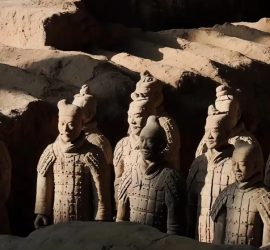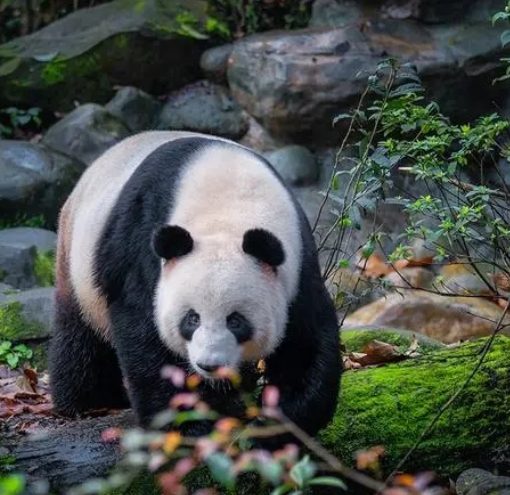The Hanyangling Tomb and Museum, situated near Xi’an in China, is an extraordinary site that provides visitors with a one-of-a-kind opportunity to explore the Han Dynasty. This impressive archaeological complex houses the final resting place of Emperor Jingdi and his empress. Within its grounds, visitors can explore a museum filled with a remarkable collection of historical artifacts and captivating exhibits. Discover the fascinating world of the Hanyangling Tomb and Museum as we delve into its rich history, highlight its key attractions, and showcase the exciting activities that await visitors.
Greetings

The Hanyangling Tomb and Museum, also referred to as the Yang Mausoleum of Han, holds immense historical and cultural importance. Situated approximately 20 kilometers north of Xi’an, this mausoleum complex has a rich history that traces back to the Western Han Dynasty (206 BCE – 9 CE). It is a significant burial site where Emperor Jingdi and his wife, Empress Wang, were laid to rest. Discover the fascinating world of the Han Dynasty on this site, where you can delve into their rich heritage through a collection of well-preserved artifacts, learn about their unique burial practices, and admire the advanced museum displays.
When you visit the Hanyangling Tomb and Museum, you’ll be taken on a journey back to ancient China. You’ll have the opportunity to delve into the fascinating life and reign of Emperor Jingdi, discover the daily routines of Han Dynasty citizens, and explore the intricate burial traditions of that time. The museum’s cutting-edge design and interactive exhibits create an immersive and informative experience for both history enthusiasts and casual tourists.
Exploring the Mausoleum of Emperor Jingdi
Introduction to Emperor Jingdi and His Rule

Emperor Jingdi, also called Liu Qi, was the sixth ruler of the Han Dynasty. During his reign from 157 BCE to 141 BCE, he focused on strengthening the central government and fostering a time of peace and prosperity. Jingdi’s policies were known for their emphasis on financial restraint and balance, which played a crucial role in maintaining economic stability and fostering growth in the agricultural sector.
The mausoleum of Emperor Jingdi showcases the principles of his rule, prioritizing simplicity and practicality rather than extravagance. Contrary to the extravagant tombs of later emperors, Jingdi’s mausoleum is comparatively modest in size, yet it holds immense cultural and historical importance.
Exploring the Mausoleum Structure
The mausoleum complex spans about 20 square kilometers and consists of the primary tomb of Emperor Jingdi, the tomb of Empress Wang, and several burial pits. Surrounding the central mound, you’ll find a collection of pits filled with an impressive array of miniature terracotta figures, animals, and everyday objects. These items were meant to accompany the emperor in the afterlife, ensuring that he could continue to enjoy the same comforts and conveniences he cherished in his lifetime.
The design of the mausoleum showcases the traditional Chinese perspective on the afterlife, where the departed would carry on with a lifestyle reminiscent of their earthly existence. The organization of the burial pits and the items found inside provide valuable information about the social hierarchy, everyday activities, and religious customs during the Han Dynasty.
Special Characteristics of the Tomb
The Hanyangling Mausoleum stands out for its unique incorporation of miniature terracotta figures. Contrary to the larger-than-life soldiers discovered in Emperor Qin Shi Huang’s renowned Terracotta Army, the figures in Jingdi’s tomb are of a smaller scale and portray a diverse array of subjects, encompassing soldiers, officials, servants, and animals. The emphasis on everyday life instead of military power showcases the peaceful and practical approach of Jingdi’s reign.
One fascinating feature of the mausoleum is the collection of remarkably preserved burial artifacts, such as pottery, bronze objects, and jade items. These artifacts offer valuable insights into the material culture and technological progress of the Han Dynasty.
Exploring the Underground Museum
Exploring the Layout and Design of the Underground Museum

The Hanyangling Tomb and Museum offers a unique underground museum experience, where visitors can delve into the burial pits and witness the artifacts in their original setting. The museum features transparent floors and walkways, allowing visitors to view the terracotta figures and other artifacts in their original arrangement within the burial pits.
The museum has a well-thought-out layout that effortlessly leads visitors through different sections of the tomb, ensuring a complete and captivating experience. The exhibits are visually enhanced through the use of natural lighting and modern display techniques, creating a seamless connection between the ancient and contemporary worlds.
Interesting Exhibits and Artifacts
The underground museum showcases a diverse range of exhibits, encompassing terracotta figures, pottery, bronze objects, and jade artifacts. Every exhibit is accompanied by informative panels that provide detailed explanations about the significance of the items and their context during the Han Dynasty.
One of the highlights of the museum is the remarkable collection of terracotta figures, featuring a wide range of characters including soldiers, officials, musicians, and domestic animals. The level of detail and realism in these figures is truly remarkable, capturing everyday life in a stunning way. Notable artifacts from the Han period include beautifully crafted pottery vessels, bronze mirrors, and jade ornaments, showcasing the artistic and technological advancements of that time.
Walking through the transparent floors is an unforgettable experience.
Exploring the underground museum on transparent floors is an extraordinary and exhilarating adventure. Visitors have the unique opportunity to observe the artifacts in their original positions by looking directly down into the burial pits. This cutting-edge design not only improves the viewing experience but also contributes to the preservation of the archaeological site by reducing physical contact with the artifacts.
The clear walkways provide a strong link to history, giving visitors the sensation of stepping into the ancient tomb. The museum’s immersive experience is taken to the next level with interactive displays and multimedia presentations that offer extra context and information about the exhibits.
Terracotta Figures
Exploring the Terracotta Figures and Their Significance

The terracotta figures at the Hanyangling Mausoleum are truly captivating. These figures were crafted to accompany and safeguard Emperor Jingdi in the realm beyond. Unlike the majestic and formidable soldiers of the Qin Shi Huang Terracotta Army, the figures at Hanyangling are more petite and portray a wide variety of subjects.
The figures consist of soldiers, officials, servants, musicians, and animals, all meticulously crafted to recreate the emperor’s court and everyday activities. The soldiers are shown in different positions, with some keeping watch while others are involved in their daily routines. The animals found in the Han Dynasty, including pigs, sheep, and dogs, were a significant part of the economy and society, highlighting the importance of livestock.
Contrasts Between These Figures and Those at the Terracotta Army of Xi’an
Although the Hanyangling Mausoleum and the Terracotta Army of Xi’an both showcase terracotta figures, they possess distinct characteristics that set them apart. The sculptures at Hanyangling are crafted on a smaller scale and primarily depict scenes from daily life, rather than emphasizing military power. This distinction emphasizes the contrasting priorities of the two emperors: Qin Shi Huang’s strong emphasis on power and conquest compared to Jingdi’s focus on maintaining domestic stability and promoting prosperity.
One thing that stands out is the meticulous attention to detail and the high level of craftsmanship. The sculptures at Hanyangling exhibit a high level of refinement and realism, showcasing intricate details of clothing, facial expressions, and poses. The meticulous attention to detail in this analysis offers valuable insights into the clothing, hairstyles, and social roles of individuals during the Han Dynasty.
Discover a Fascinating Glimpse into the Daily Life of the Han Dynasty Depicted Through These Figures
Visiting Hanyangling allows you to gain fascinating insights into the everyday routines of the Han Dynasty. The depictions of soldiers, officials, servants, and animals offer a thorough insight into the social structure and daily routines of that era.
As we observe the figures from the Han Dynasty, we can see the significant role that music and entertainment played in their culture. The presence of musicians and entertainers among these figures is a clear indication of their importance. The presence of domestic animals emphasizes the importance of agriculture and livestock in the economy. The assortment of figures also mirrors the hierarchical structure of Han society, where distinct roles and responsibilities are assigned to various social classes.
The Burial Pits

Exploring the Various Burial Pits
The Hanyangling Mausoleum complex features a variety of burial pits, each housing a distinct collection of artifacts and terracotta figures. The pits are strategically arranged around the central mound, reflecting the traditional Chinese belief in the afterlife and the importance of ensuring provisions for the deceased in their journey to the next world.
Every pit is devoted to a particular category of items, ranging from military figures to domestic animals and everyday objects. The arrangement of the pits offers valuable insights into the burial practices and beliefs of the Han Dynasty.
Various artifacts have been discovered in the pits, such as pottery, animals, and chariots.
The burial pits at Hanyangling house a wide variety of artifacts, such as pottery vessels, terracotta animals, bronze objects, and chariots. The items were meticulously chosen and organized to ensure that the emperor and his court would have all their necessities in the afterlife.
The pottery vessels, for example, come in a wide range of shapes and sizes, showcasing their versatility in various aspects of everyday life, like cooking, storage, and ritual ceremonies. The terracotta animals, such as pigs, sheep, and dogs, serve as a testament to the significant role that livestock played in Han society. The inclusion of chariots and horse figures suggests the importance placed on transportation and military readiness.
Analysis of the Burial Customs during the Han Dynasty
The burial practices of the Han Dynasty, as seen in the Hanyangling Mausoleum, showcase a profound respect for the afterlife and a commitment to ensuring the welfare of the departed. The careful organization of artifacts and figures in the burial pits indicates a belief in the continuation of life after death. It suggests that the deceased would still need the same comforts and necessities as they did in their earthly life.
The practical and pragmatic nature of Han burial practices is evident in the inclusion of everyday objects, animals, and chariots. Instead of solely emphasizing grand and symbolic items, the Han Dynasty also prioritized meeting the practical needs of the deceased, creating a well-rounded and comprehensive provision for the afterlife.
The Exhibition Hall

Highlighted Displays in the Main Exhibition Hall
The main exhibition hall at the Hanyangling Museum offers a diverse range of exhibits that allow visitors to delve into the cultural, social, and technological achievements of the Han Dynasty. The hall showcases a wide array of artifacts discovered from the mausoleum, each carefully selected to showcase various aspects of life during the Han Dynasty.
Notable features of the Exhibition Hall are:
Discover a stunning collection of bronze and jade artifacts:
These artifacts showcase the impressive metallurgical and artistic abilities of the Han craftsmen. The collection includes bronze mirrors, tools, and ceremonial vessels that provide valuable insights into the daily life and religious practices of the time. Additionally, there are intricately carved jade ornaments that showcase the opulent preferences of the Han elite.
Discover the world of pottery and ceramics:
The pottery showcased features a range of practical items as well as ornamental pieces. The wide range of shapes and sizes reflects the diverse purposes of these objects in cooking, storage, and rituals. The ceramics showcase the impressive mastery of kiln technology and glazing techniques during the Han period.
Textiles and Clothing:
Pieces of textiles and reproductions of clothing offer a fascinating look into the world of fashion and fabric manufacturing during that era. The exhibition features a variety of silk garments that were highly valued and traded along the Silk Road. These exquisite pieces highlight the exceptional craftsmanship and the intricate trade connections of the Han Dynasty.
Weapons and Armor:
Featuring a wide range of military artifacts, the exhibition showcases an impressive collection of swords, spears, and pieces of armor. These items showcase the impressive military technology and highlight the crucial role of the armed forces in safeguarding the empire and extending its dominion.
Household Items and Tools:
Objects commonly used by Han Dynasty citizens, including kitchen utensils, farming tools, and household furniture, provide valuable insights into their daily lives. These artifacts provide valuable insights into the daily life of people during this period.
Exploring the art of calligraphy and historical documents:
The significance of literacy, administration, and communication is showcased through examples of Han Dynasty calligraphy and written documents. These exhibits feature bamboo slips and silk manuscripts, offering a glimpse into the early forms of Chinese writing and documentation.
Experience the world of multimedia and interactive displays
The exhibition hall is equipped with state-of-the-art multimedia and interactive displays, creating an immersive and engaging experience for visitors. Our interactive displays offer a truly engaging educational experience with touchscreens, 3D models, and virtual reality stations. Visitors have the option to use interactive maps to follow the trade routes of the Silk Road or view animations that showcase the construction of the mausoleum and the lives of the people involved in its creation.
The interactive features enhance the exhibits, enabling visitors to explore the historical context and develop a deeper understanding of the Han Dynasty.
Recommendations for Things to Do and See
Explore our selection of guided tours and educational programs

The Hanyangling Tomb and Museum provides a variety of guided tours and educational programs designed to cater to various age groups and interests. Experienced guides offer detailed insights into the exhibits, the historical importance of the artifacts, and the archaeological findings at the site.
For school groups and families, the museum offers educational workshops and hands-on activities that provide an immersive learning experience on Han Dynasty culture and history. These programs are created with the intention of making learning enjoyable and easily accessible for younger visitors.
Experience a variety of captivating cultural performances and demonstrations

Throughout the year, the museum organizes various cultural performances and demonstrations that vividly showcase the traditions of the Han Dynasty. These events often feature traditional music and dance performances, calligraphy demonstrations, and reenactments of historical events. These cultural activities offer a truly immersive experience, enabling visitors to fully appreciate the rich artistic and cultural heritage of the Han Dynasty.
Special Exhibitions and Temporary Displays
Aside from the permanent exhibits, the Hanyangling Museum frequently showcases special exhibitions and temporary displays. These exhibitions may explore various topics, such as the Silk Road, the evolution of Chinese ceramics, or the significance of women in Han society. Temporary exhibits frequently feature loaned items from other museums, offering a vibrant and ever-changing experience for visitors who come back again and again.
Exploring the Great Outdoors
The museum complex features exquisitely designed gardens and outdoor spaces that capture the essence of traditional Chinese garden aesthetics. Visitors can explore these peaceful areas, immersing themselves in the beauty of nature and finding a sense of calm. The gardens create an ideal atmosphere for contemplation and unwinding, elevating the overall enjoyment for visitors.
Exploring Ancient Ruins

If you have a passion for archaeology, the museum provides guided visits to the active excavation sites within the mausoleum complex. These tours offer a unique opportunity to witness the ongoing archaeological work, providing insights into the techniques used to uncover and preserve ancient artifacts. Visitors have the opportunity to witness archaeologists in action and stay updated on the latest discoveries.










